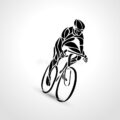How to make a mountain bike faster
Whether you are a beginner at mountain biking or are an experienced rider, everyone wants to go fast on their mountain bike. While mountain bikes can be relatively fast, they can be particularly slow as compared to other bikes such as hybrid bikes or road bikes.
It can be quite a shock to move to a snappy new road bike from a mountain bike. Road bikes can be twitchy, light, small, and easy to handle. Compared to a mountain bike the contrast in speed can be huge.
WHY IS MY MOUNTAIN BIKE SO SLOW
Mountain bikes are slower than hybrid bikes, and road bikes because of their typically larger tires, slow gearing, less aerodynamic riding position, suspension, heavier bike weight, and longer frame geometry.
However, you can typically increase the speed of your mountain bike, particularly on climbs by making a few changes to the bike and how you ride. In this article, we take a look into why mountain bikes tend to be slower than road bikes and how to make them faster.
HOW MUCH FASTER IS A ROAD BIKE THAN A MOUNTAIN BIKE?
The typical road bike is between 10 to 30% faster than a mountain bike. It can also be up to 15% faster than a mountain bike on paved surfaces given the same power output.
Some of the reasons why the road bike is faster include lesser weight, better frame geometry, less rolling resistance, and aerodynamic riding posture as compared to the mountain bike.
- Speed and Riding Position
The greatest determination of speed over long distances is riding position. Since you are riding in an upright posture on a mountain bike, you could be up to two times slower as compared to riding a road bike as you will ride on the drop bars. As such the faster you go on a mountain bike the more drag and wind slow you down.
- Rolling Resistance
The interaction between the terrain and the tie is what is known as rolling resistance. When comparing a road bike to a mountain bike, this can be impacted by:
- Tire width – the wider and heavier tires of a mountain bike are slower and heavier
- Tire Pressure – The lower pressure means more contact and friction with the ground which makes pedaling harder.
- Tread Type – The larger tread increases friction making the mountain bike slower
- Wheeler Diameter – The smaller diameter tire of the mountain bike makes it easier to deform making them less efficient and slower.
These four factors make for a low-pressure, knobbier, larger, and heavier bike as compared to narrow and sleek bike tires which have minimal friction thus making them faster.
- Bike Weight
You will typically lose 1 mph for every 12 pounds gained. Given that the typical full suspension mountain bike weighs 30 pounds as compared to just 17 pounds for the road bike, the road bike will be at least 1 mph faster than the mountain bike.
- Frame Geometry Differences
Road bikes place the rider in a more aerodynamic position that reduces wind resistance and drag and also enhances pedaling efficiency. Meanwhile, the upright riding position of the mountain bike is designed for stability and control but significantly reduces pedaling efficiency and increases drag.

- Gearing
Most mountain bikes are designed for off-road riding and climbing and hence do not have big gears. Since road bikes are made for high speeds and long-distance riding they tend to come with a broader range of gear combinations which increases pedaling efficiency thus making a rider faster over long distances.
13 TIPS AND TRICKS TO MAKE YOUR MOUNTAIN BIKE FASTER
Even though the mountain bike will always be slower than most other bikes, there are several tips and tricks you can employ to speed on your mountain bike. Some of these include:
- Thinner Less Aggressive Treaded Tires
Go for tires with a less aggressive tread. While you may need the traction as a beginner, wide and aggressive tires will slow you down significantly due to the friction they have with the ground.
A narrower less aggressively treaded tire provides much less surface area in contact with the ground thus reducing rolling resistance.

- Optimize Tire Pressures
Pump up your tires to between 25-35 PSI which will reduce the surface area in contact with the ground while you are cycling. Less contact with the ground results in lesser rolling resistance thus allowing you to go faster. You could also opt for different pressures depending on the terrain that you will be riding on.
- Shift to Tubeless Tires
Tubeless tires mean you repair fewer flats but since they are also lighter, the wheel will rotate more easily. The lower rotational resistance makes for faster acceleration in preparation for banks and climbs.
- Use Clipless Pedals
While almost every experienced mountain bike is clipless, many beginners are not. The advantage of clipless pedals is that they allow for a more consistent and powerful stroke as your foot will not be slipping off all the time thus making it possible to apply consistent power which results in faster riding.
- Lubricate the Drivetrain
A well-lubricated drivetrain which includes the derailleurs, chain, rear cassette, and chainring is more efficient and the saved energy from such a drivetrain will be translated to the wheels thus allowing you to get more speed with each pedal stroke.
- Replace the Bike Chain
Stretchy chains will be less efficient and may keep popping off thus making you have to stop to get it back on making you slower. An old chain will also be less efficient at transferring power to the drivetrain. Get your chain checked and if it is too old you should have it replaced to make it more efficient.
- Optimize Your Shifting
With a well-oiled and fresh chain, you should also ensure that the cable tension and the derailleurs are properly configured so that you can get smooth shifting. Smoother shifting will allow for optimum power delivery and more efficient riding thus greater speeds.
- Swap out the Cassette
Most cassettes last no more than 1000 miles and hence if you have an old one you should get a new one. A good rule of thumb is to replace a cassette when you have gone through two to three chains as worn-out cassettes will not allow for proper shifting.
- Align Your Brakes
Brakes are meant to slow you down from riding off a mountain but you don’t want them slowing you down unnecessarily.
When it comes to brakes the key is to check that there are no bends to the brake rotors where the brakes may rub on the pads slowing you down when you don’t need to.
There are several types of tools including a wrench and disc brake tool you can use to check for any rubbing or bends in the wheels and rotors.
- Tune the Suspension
You will need to find a balance between too-hard and too-soft suspensions. The latter will result in slower riding as they will absorb too much energy while the former will kick around so much making it impossible to ride in a straight line.
For a mountain bike you will need to adjust the fork and rear suspensions, sag, progression, and rebound damping are critical when dealing with the suspension on a mountain bike.
- Perfect Your Saddle Position
Adjust your saddle to a perfect position and height which will improve pedaling efficiency. What you want is to have a slight bend to the knee at the bottom of the stroke.
While you can always use a dropper post to quickly lower your seat on descents, having the proper adjustment will significantly enhance your efficiency and speed.
- Clean Your Bike

Even with all the replacing and adjusting, a dirty bike will not run as efficiently and as fast as you want. You should use lubricant for the drivetrain and soap and water to clean out all the gunk, dirt, mud, and grime to make your bike an efficient speed machine.
- Ride in a More Aerodynamic Profile
Wear tighter-fitting clothing, consider lowering the handlebars, and adopt a narrower grip to make a more tucked position. This will reduce the drag thus making you more efficient.
You could also remove any unnecessary components from the mountain bike such as lights, pouches, and water bottle holders that would add needless weight and wind resistance.


